WE NEED A BACK DOOR
It is the middle of a pretty cold winter here in Montgomard, so renovation is going at a slow pace, with frequent stops to warm up. However, planning for the real renovation season, which starts in March is fairly well advanced, with some major works scheduled for this year.
When we bought our early nineteenth century French cottage it came with a number of pigsties attached which, up until now, we have used for storage. It also had no back door, as the passage which led to the back door had been blocked up and made into a shower room some years ago. We decided early on to install a back door, to avoid tramping so much dust and dog shit in through the front door and we have a quote to knock a hole through one of the walls in the back kitchen and install a door.
The thing is that the other side of the wall there are two pigsties which we intended to demolish completely. They are some two and a half metres front to back and together measure about five metres across and this would give us some twelve and a half square metres of floor space if we could convert them into a room rather than demolish them. A diagram will help explain.
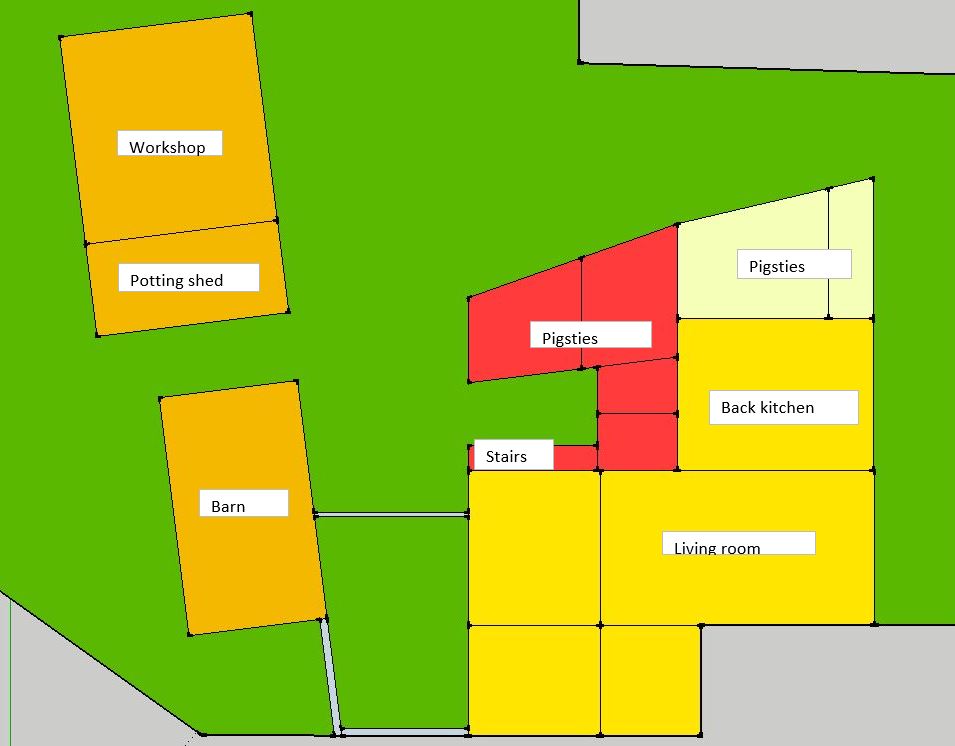
Originally, all of the pigsties marked in red, plus the outside staircase, were going to be demolished, so that the door at the rear of the back kitchen led directly to the outside.
At this point I should perhaps explain why we call it a back kitchen instead of just a kitchen. You see, the living room is set out as a farmhouse kitchen. A large dining and food preparation table, comfortable armchairs, a wood burning stove and a huge cooker with two ovens and half a dozen gas burners. So to distinguish the kitchen that contains the sink, storage cupboards, fridges, freezers and a hundred and one mixers, beaters, blenders, choppers and electric bottle openers, I call it by its French name, back kitchen. When I was a kid, we would have called it a scullery.
The problem with our original design was that the back yard contains as much muck to be traipsed into the house as the front yard. What we really need is a decontamination area, a shitlock if you like, where the outside could be peeled off before entering the house proper. In old English country houses this function is provided by a boot room, where you can leave all your riding gear and wet dogs and the more I looked at our two pigsties, the more they looked like a potential boot room to me.
The latest plan is therefore to demolish the two large pigsties, plus the outside staircase and convert the two small sties attached to the back kitchen into a laundry and boot room.
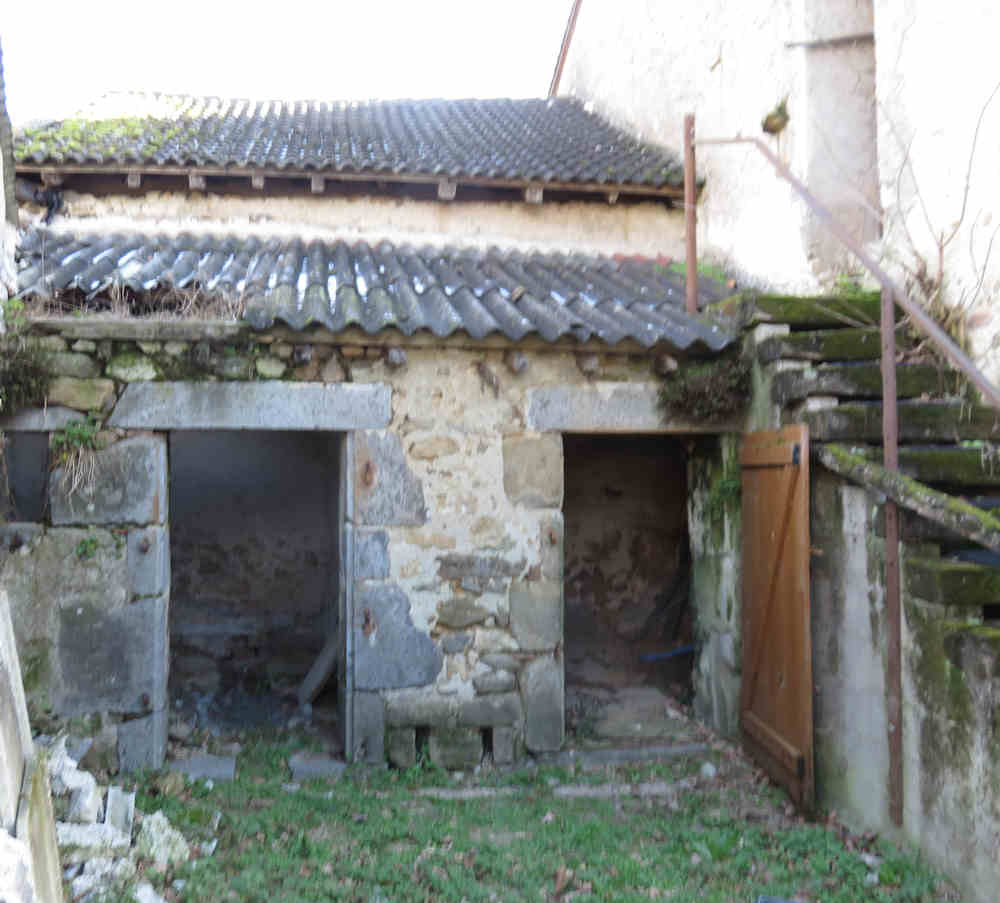
At this point, you are probably sceptical of the idea of making a real room out of a pig's sty, so you need to understand how the pigsties are constructed. The house is built of large granite dressed blocks at all the corners, door and window openings and granite boulders, plugged with lime and earth in between those points. The walls are half a metre thick and the whole structure is tied together with huge oak beams. What makes the plan possible is that the pigsties are constructed in exactly the same fashion.
Here are the two pigsties that we are planning to convert, with the old outside staircase to the loft on the right. The walls are the same half a metre thick as the house and there are dressed granite blocks around the openings. The roof, which is corrugated sheet over rotted beams, will be completely replaced. The doors are currently about five and a half feet tall, so the other major work will be to raise the lintels above the openings using granite blocks from the pigsties we demolish.
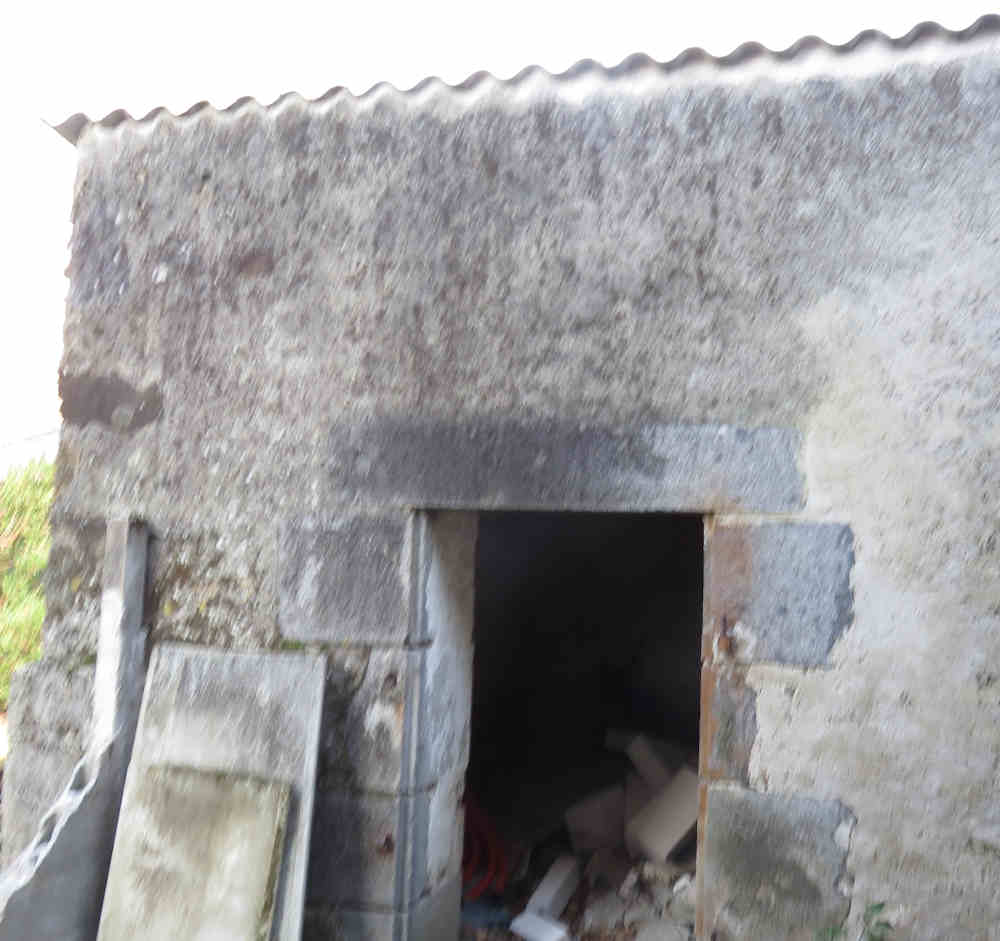
Here is one of the sties that will be demolished. As you can see, there will be plenty of nicely dressed granite blocks and at least one granite lintel to go above a new window opening.
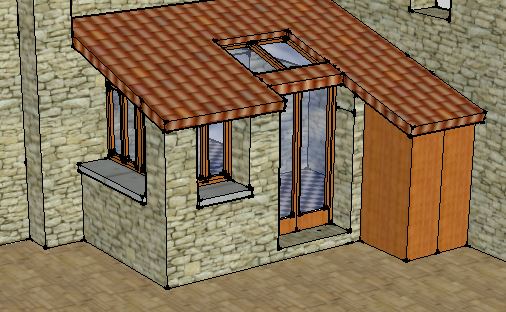
Because we will be taking the house floor area over a local planning department limit. We need to employ an architect to prepare the planning dossier, but I have done a quick Sketchup drawing to show what it may look like.
There is already water and drainage running through the pigsties and the electricity supply is just the other side of the back kitchen wall. Aside from heaving a few large granite blocks around, I don't see too many problems with the construction. I reckon you can build at least part of a house out of a pig's sty. Come back later in the year to see how we are getting on.
A bit later in the year
It is now the middle of March and we have changed our minds about the renovation priorities for this year. There was a big storm a couple of weeks ago and we not only lost all the glass in the greenhouse, but some more tiles and roof supports from both the lean-to potting shed and the single storey barn.
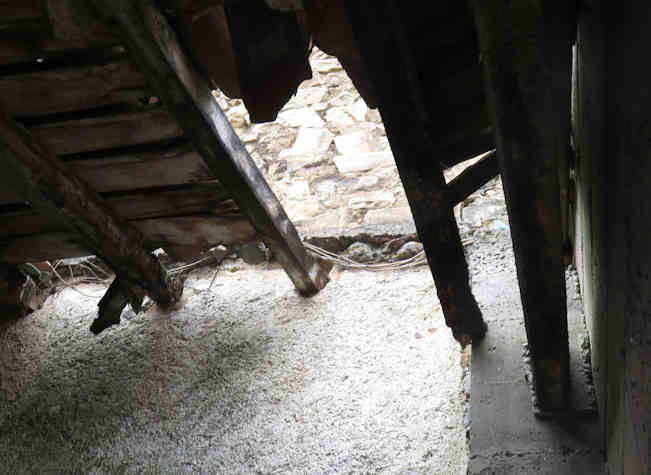
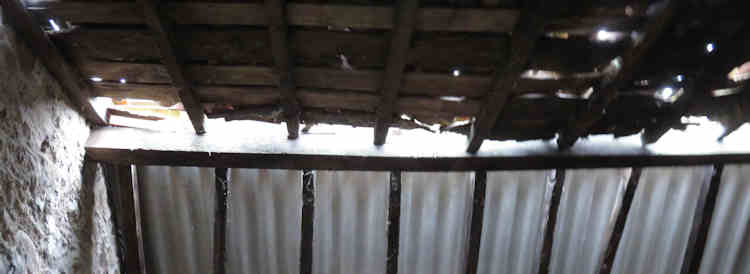
There is now a serious probability that we could see one or both roofs collapse in the next storm. We are now trying to contact our friendly local stonemason and roofing specialist to see if he can fit us in this spring or summer. If he can, the boot room will be delayed till next year.
THE FRENCH HAVE A GENDER FOR THAT
Whereas in English most nouns are neuter, in French most are either masculine or feminine. A cow (vache) is feminine and a bull (Toreau) masculine; so far, so easy. A wall (mur) is masculine, except when it is a tunnel wall (paroi), which of course is feminine. Not so hard is it. The Great wall of China (Grande Muraille de Chine) and any other wall round a city is feminine. A railway station (gare) is feminine and a train (train) is masculine. I could go on, but I think you can see the pattern and given that all this was worked out by a bunch of doddery old male fools who didn't get out in the fresh air much, I think you can see why.
Of course, Camilla, who is some sort of language expert, tells me that I am talking out of my masculine arse (cul) and that it is all to do with Latin word roots. But me and a bunch of internet conspiracy theorists are not so sure.
Anyway, with gender such a big part of the French language, it may come as something of a surprise to learn that most French people haven't got a clue as to why someone in Mississippi or North Carolina should get so upset about which toilet you choose to use. In our part of the French countryside, you often don't get a choice in a café or restaurant as there is only one. I once opened an unlocked toilet door to find an elderly lady relieving herself. Being in France, we both apologised politely, wished each other a good morning and I retreated to stand guard outside the door until she had finished. The only reason we did not kiss or shake hands was that there was no third person there to formally introduce us.
The French are, in large part, laid back about how a person sees their gender. Maybe it's because of the fashion industry, or maybe the world-renowned artists or maybe, just possibly, there is something still left of the Liberty, Equality, Fraternity cry that came from the revolution.
The strict definition of gender via a binary chop into male and female whilst making for a good working definition for organising our daily life must admit to a looser definition if it is to describe us accurately.
At the genetic level, the differences between male and female are incredibly small. For instance, the activity of a single gene FOXL2 stops adult ovary cells turning into Testes cells. That's adult cells folks, scary or what. Likewise, the old sex differentiation between XX and XY (female and male) chromosome pairs has not stood up to modern research. Not only that, but there is some argument that the Y chromosome will die out in a couple of million years. It is much simpler than the x chromosome, with only thirty genes against eight hundred. Simple souls us males.
It used to be thought that female was the default state, but that the XY chromosome caused a once and for all movement to male. It turns out that things are a lot more complex with pro-male and anti-male genes battling it out to the last minute and sex being determined by a fine imbalance. Damn, a couple of extra seconds and I could have made a fortune as a top fashion model. It is worth saying that these genes could just as easily have been described as anti-female and pro-female.
Given all this then I think that in France, we will just continue to be polite to each other in the toilet.
WOLVES
Wolves tend to evoke strong reactions in us humans. A few of us love them and the majority hate them. Culturally, they have a bad name of course; Big Bad Wolf. They kill grannies and cute little pigs. They chase sleighs full of terrified humans and, in the worst case, can change from human to wolf and back again.
Livestock farmers would like to see them all slaughtered. As of 2015, the Wolf population of Europe was some 12,000 and apparently in the first three months of 2016, wolves killed some 47,500 sheep in Europe, which sounds a lot. But out of a 2015 European sheep population of some 120 million, that is approximately 0.04%, about the same number as die of unspecified illness. In a full year, a fifth of one percent would be taken by wolves. Humans waste far more than this, throwing away perfectly edible lamb and mutton.
Myths and folk tales
There are probably more myths and folk tales about wolves than about any other animal, with the possible exception of ravens. They occur on every inhabited continent, from the late Iron age through to the twentieth century. Here are a few of them:
- In one Greek myth, king Lycaon was turned into a wolf by Zeus and the scientific name of the Eastern timber wolf, Canis Lupus Lycoan reflects this.
- St Francis so tamed a wolf terrorising the people of the town of Gubbio that it spent the rest of its life living in the town and going from door to door for food. Which sounds to me like a pretty sad existence.
- The founders of Rome, Rumulus and Remus were suckled by a wolf and fed by a woodpecker after they were cast into the river Tiber.
- The Navajo believed that wolves were witches in wolf's clothing.
- In Europe in the middle ages, there were many strange ideas about wolves: Powdered wolf liver eased birth pains; A horse who stepped in a wolf print would be crippled; The gaze of a wolf causes blindness.
- Dead wolves were buried at a village entrance to keep out other wolves (a bizarre belief echoed today by farmers who continue to shoot predators and hang them on fence posts to repel other predators.)
- Travelers were warned about perils of walking through lonely stretches of woods, and stone shelters were built to protect them from attacks.
Of course, we cannot leave the topic of wolf myths and folk tales without mentioning werewolves. A werewolf or lycanthrope is a human who at certain times has the ability to change form into that of a wolf. Belief in werewolves sat alongside belief in witches and it is difficult to differentiate the two most of the time. Werewolf tales tend to be more exciting than witch tales, with odd tales of love and loyalty mixed in with the usual blood and gore. Werewolves tend to be a greater part of folk tales the further east in Europe you go. The black forest is not called the black forest by accident.
Wolf facts
The agreed taxonomy of wolves is as follows.
Class - Mammals - Mammary glands and hair
Family -- Canidae - Dog like with 42 teeth
Genus - Canis - Dogs, wolves, jackals et al.
Species - Canis lupus - Grey wolf
Canids originated some 40 million years ago and are the oldest family of carnivores (meat eating mammals). There are fourteen recognised genera and thirty four different species in the Canid family, of which there are six species of wolf; the Grey wolf (Canis lupus), the Red Wolf (Canis rufus), the Indian Wolf (Canis indica), the Himalayan wolf (Canis himalayaensis), the Eastern Canadian Wolf (Canis lycaon) and the Ethiopian Wolf (Canis simensis).
Once we get below species, then the waters get very muddy. Whilst many sub-species of Wolf have been proposed, few have been agreed on and some people argue that there no sub-species. We will know once enough DNA studies are done.
How I came to love wolves
I first became interested in wolves through the writings of the American Indian mystic
Some years ago, I discovered the UK wolf conservation trust (UKWCT), located at Beenham in Berkshire. They keep a small pack of wolves, many of which you will have seen in films and T.V. shows and you have to know that it takes a lot of training to make them look fierce for the camera. They also give considerable sums of money for wolf research around the world. If you book a visit you can go walking through the woods with wolves and attend howl nights. UK wolf conservation trust
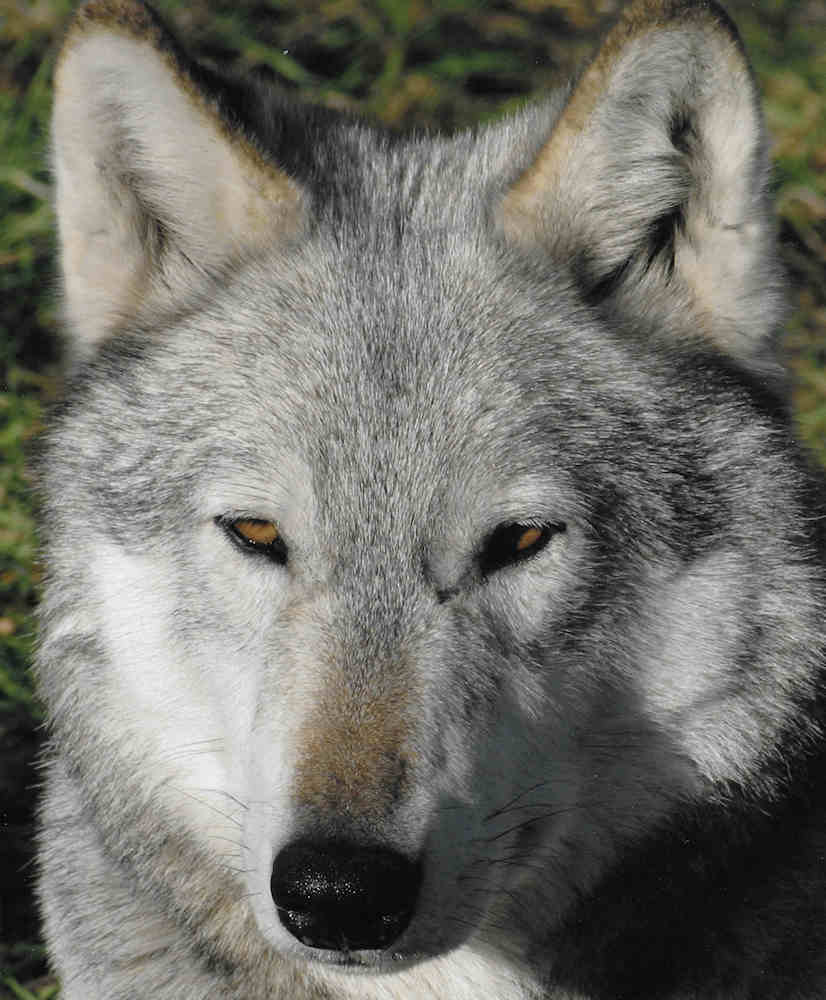
On the right is Duma, a wolf whose upkeep I supported at Beenham.
She finally died of old age about four years ago, but in her prime, she was a beautiful and gracious lady
And below is Duma with her sister Dakota.
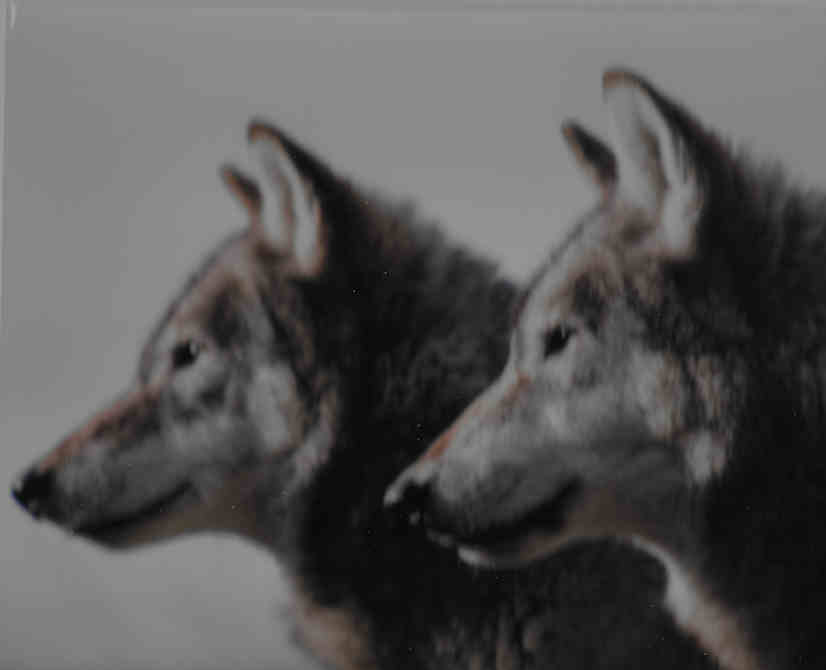
Since moving to France, we have found a wolf sanctuary some fifty kilometres to the east of us. Les Loups de Chabrieres is not so hands-on as the UKWCT, but is well laid out and well worth a visit. Chabrieres animal park
Fido the wolf

Inside every Chihuahua lurks a wolf, as DNA analysis and genetic drift studies have shown that all domestic dogs are descended from ancient wolves. Dogs and modern wolves are sister clades descended from a common ancient wolf .
When and where wolves were first domesticated is a subject of much debate. Certainly before civilisation and agriculture and probably in more than one place, If you think about it, human and wolf hunters operate in much the same manner. They can hunt as individuals but are more likely to succeed as a group. They were therefore competitive top predators before domestication, so hunting cooperatively with them would have come sometime after domestication, but how long after we have no idea. Dog lovers will be glad to know that domestication is likely to have arisen from friendly wolves cuddling up near to camp fires after raiding the midden for scraps. The rest of the story is just us fiddling about with their genes.